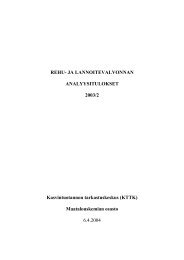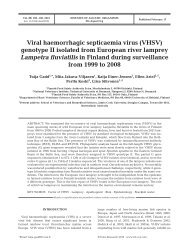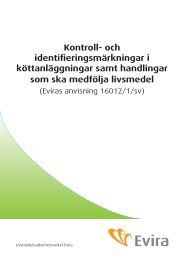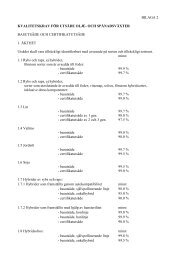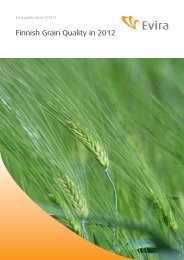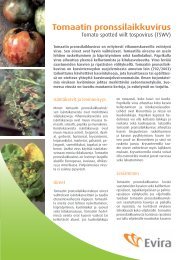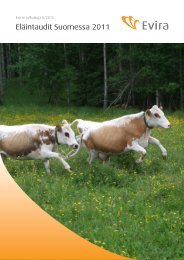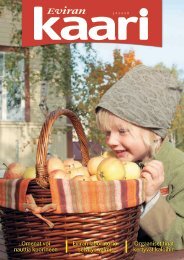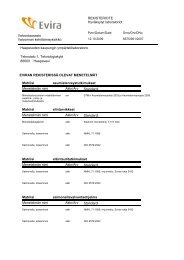Genetic characteristics of field and attenuated rabies viruses ... - Evira
Genetic characteristics of field and attenuated rabies viruses ... - Evira
Genetic characteristics of field and attenuated rabies viruses ... - Evira
You also want an ePaper? Increase the reach of your titles
YUMPU automatically turns print PDFs into web optimized ePapers that Google loves.
<strong>of</strong> a vaccinia-<strong>rabies</strong> recombinant virus administered by the oral route in foxes. Because <strong>of</strong><br />
its safety <strong>and</strong> heat-stability, this recombinant virus could be an excellent alternative to the<br />
<strong>attenuated</strong> strains <strong>of</strong> <strong>rabies</strong> virus currently used in the <strong>field</strong> (Brochier et al., 1990, 1991,<br />
1996; Desmettre et al., 1990; Lambot et al., 2001). The high thermo stability <strong>of</strong> the<br />
commercially produced Raboral VRG bait allows its use during the summer for<br />
emergency vaccination campaigns (Masson et al., 1999), <strong>and</strong> is being used for the<br />
vaccination <strong>of</strong> wild raccoons in the USA (Olson et al., 2000). The VRG vaccine has also<br />
been tested as an oral vaccine in vampire bats <strong>and</strong> significant protection was observed in<br />
animals vaccinated 18-30 days before challenge (Setien et al., 1998).<br />
Oral vaccination <strong>of</strong> wild animals has been successfully conducted in many<br />
countries: such as Austria, Croatia, Switzerl<strong>and</strong>, Italy, Germany, Slovenia, Czech<br />
Republic, Slovakia, Israel, USA, Canada, Belgium, France, etc. (Steck et al., 1982;<br />
Westerling, 1989; Gram, 1996; Separovic, 1996; Schluter, 1996; Svrcek et al., 1996;<br />
Matouch, 1996; Mutinelli, 1996; Linhart et al., 1997; Olson et al., 1999, 2000; Hostnik,<br />
2000b; MacInnes et al., 2001). The sylvatic <strong>rabies</strong> epidemic <strong>of</strong> 1988-1989 was<br />
successfully eradicated in Finl<strong>and</strong> by the oral immunization <strong>of</strong> wild carnivores (Nyberg et<br />
al., 1992), <strong>and</strong> was also used in some areas <strong>of</strong> Russia. One <strong>of</strong> these vaccination areas is<br />
located at the Finnish-Russian border within the Leningrad region <strong>and</strong> the Republic <strong>of</strong><br />
Karelia. The oral vaccination was organized in 2003 within the framework <strong>of</strong> the<br />
international Finnish-Russian collaboration program for controlling <strong>rabies</strong> in wildlife, <strong>and</strong><br />
financially supported by the EU <strong>and</strong> the Finnish government (Metlin et al., in press).<br />
The most common strategy for conducting oral vaccination campaigns is to use<br />
vaccine baits at a density <strong>of</strong> approximately 25 baits per square km, twice a year, during<br />
the spring <strong>and</strong> autumn, to avoid the negative influence <strong>of</strong> temperature on vaccine baits<br />
<strong>and</strong> to reach adult foxes (in spring) <strong>and</strong> juvenile foxes before they disperse (in autumn)<br />
(Aubert et al., 1994; Vos, 2003). However, further studies on the population dynamics <strong>of</strong><br />
the red fox, the onset <strong>and</strong> progress <strong>of</strong> the reproductive season, <strong>and</strong> maternal immunity<br />
<strong>and</strong> the immune response <strong>of</strong> fox cubs to oral vaccination have shown that it was<br />
necessary to optimize the old strategy <strong>and</strong> conduct two spring vaccinations: first in<br />
March, <strong>and</strong> then before the end <strong>of</strong> May to cover young foxes (Muller et al., 1999, 2001;<br />
Vos et al., 2001).<br />
29



